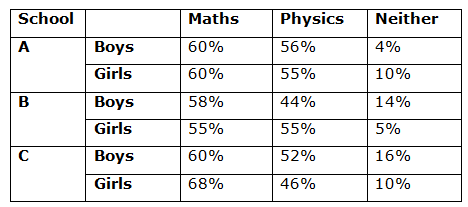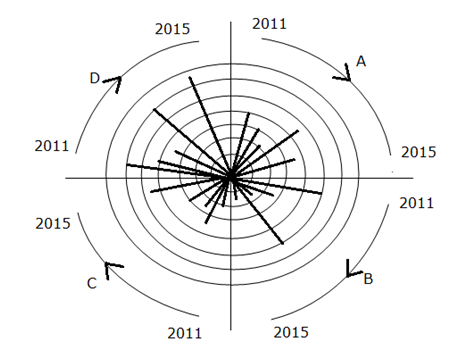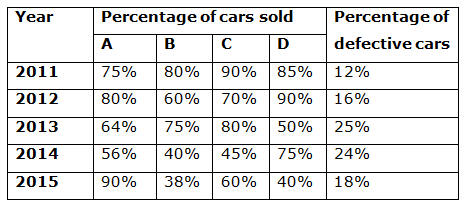SBI PO 2019 Notification is about to come and it is the most awaited exam among the aspirants. We all know that new pattern questions are introducing every year in the SBI PO exam. Further, the questions are getting tougher and beyond the level of the candidate’s expectations.
Our IBPS Guide is providing High-Level New Pattern Quantitative Aptitude Questions for SBI PO 2019 so the aspirants can practice it on a daily basis. These questions are framed by our skilled experts after understanding your needs thoroughly. Aspirants can practice these high-level questions daily to familiarize with the exact exam pattern. We wish that your rigorous preparation leads you to a successful target of becoming SBI PO.
“Be not afraid of growing slowly; be afraid only of standing still”
[WpProQuiz 4954]
Click Here for SBI PO Pre 2019 High-Quality Mocks Exactly on SBI Standard
Click here to View Quantitative Aptitude Questions in Hindi
Directions (1 – 5): Study the following information carefully and answer the given questions.
The following table gives the percentage distribution of number of boys and girls likes a maths or physics or neither in three schools A, B and C.

- The number of boys in school A is 200 which is 11.11% more than the number of girls in the same school.
- The ratio of the number of boys to girls in school B is 5: 4. If 50 more girls joined in the class then the ratio of boys to girls becomes equal.
- The number of girls in school C is one-fourth of the total number of boys in the school A and the number of girls in the school B together and the ratio of the number of boys to girls are in the ratio 3: 2.
Note: Students like Only Maths, Only Physics, both Physics and Maths and neither Maths nor Physics.
1) Find the total number of girls like only one subject in all the three schools?
a) 334
b) 216
c) 343
d) 288
e) 224
2) In which of the following school, the difference between the number of boys and the number of girls like at least one subject, is maximum?
a) School B
b) Both School A and B
c) School C
d) Both School B and C
e) None of these
3) Quantity I: Total number of boys like only one subject in school C is what percentage more than the total number of girls like only Physics in school A?
Quantity II: The number of boys like both Physics and Maths in school A, the number of girls like both Physics and Maths in school B and the number of boys like both physics and maths in school C is what percent more/less than the number of girls like only Physics in School B?
Quantity III: The number of girls like both Physics and Maths in school C is what percentage of the number of boys like only Maths in the same school?
a) Quantity I > Quantity II ≤ Quantity III
b) Quantity I > Quantity II > Quantity III
c) Quantity I ≤ Quantity II < Quantity III
d) Quantity I > Quantity II < Quantity III
e) Quantity I ≥ Quantity II ≥ Quantity III
4) What is the difference between the total number of boys like only one subject and the total number of girls like neither Physics nor Maths?
a) 373
b) 343
c) 356
d) 442
e) 392
5) Find the ratio between the total number of students like neither Physics nor Maths and that of the total number of students like both Physics and Maths?
a) 108: 223
b) 112: 117
c) 105: 221
d) 119: 97
e) None of these
Directions (6 -10): Study the following graph carefully and answer the given questions.
The figure below shows the number of cars manufactured by four companies A, B, C and D in the year 2011 – 2015. The innermost circle represents 1000 cars; the next circle represents 2000 cars, and so on. Each represents a particular manufacture and the five lines in each quadrant correspond to the years 2011 – 2015 in clockwise order.

Note: If the line is between two circles it is consider as 500 cars.
The table shows the percentage of cars sold in four companies A, B, C and D and the percentage of defective cars for all the given companies.

Note: Defective cars are not consider for sales
6) Find the total number of defective cars manufactured by company B and C in the year 2012 and 2014 respectively?
Statement I: Number of defective cars manufactured in the year 2012 by company B is 50 more than company C and 150 less than company A. The number of defective cars manufactured by company D in 2012 is 18% of the total cars manufactured by company C in the same year.
Statement II: Number of defective cars manufactured by company C in the year 2014 is twice the number of defective cars manufactured by company B in the same year which is 300 less than the number of cars defective cars manufactured by company D in the same year.
a) Only I alone
b) Only II alone
c) Either I or II
d) Neither I nor II
e) Both are necessary
7) Which of the following statement is true according to the given information?
I) The difference between the number of cars sold by company B in the year 2011 and the number of cars sold by company D in the year 2013 is 2250.
II) The ratio of the total cars sold by company C in the year 2014 and 2015 together to the total cars sold by company A in the year 2013 and 2014 together is 81: 76.
III) The total number of cars manufactured by company A and B in the year 2011 is equal to the total number of cars manufactured by the same company in the year 2014.
a) Only I
b) Only III
c) Both the options (II) and (III)
d) Both the options (I) and (II)
e) All the option (I), (II) and (III)
8) In which of the following year, the number of defective cars manufactured is minimum in the given years?
a) 2012
b) 2015
c) 2013
d) 2011
e) 2014
9) Quantity I: Find the total number of cars sold by company C in the given years.
Quantity II: Find the total number of cars sold by company D in the given years.
a) Quantity I > Quantity II
b) Quantity II > Quantity I
c) Quantity II ≥ Quantity I
d) Quantity I ≥ Quantity I
e) Quantity I = Quantity II (or) No relation
10) In which of the following company has maximum increased percentage in the year 2014 from the previous year (comparing the total number of manufacturing cars)?
a) A
b) D
c) B
d) C
e) None of these
Answers :
Directions (1 – 5):
School A:
Number of boys = 200
Number of boys = (100 + 11.11) % of the number of girls (Substitute the value of 100/9 instead of 11.11)
Number of girls = 200 * (900/1000) = 180
Boys:
Number of boys like Physics = (60/100)*200 = 120
Number of boys like Maths = (56/100)*200 = 112
Number of boys like neither Physics nor Maths = (4/100) * 200 = 8
Total = Only Physics + Only Maths + Neither Physics nor Maths – Both Physics and Maths
200 = 120 + 112 + 8 – Both physics and Maths
Both Physics and Maths = 240 – 200 = 40
Only Physics = 120 – 40 = 80
Only Maths = 112 – 40 = 72
Girls:
Number of girls like Physics = (60/100)*180 = 108
Number of girls like Maths = (55/100)*180 = 99
Number of girls like neither Physics nor Maths = (10/100) * 180 = 18
Total = Only Physics + Only Maths + Neither Physics nor Maths – Both Physics and Maths
180 = 108 + 99 + 18 – Both physics and Maths
Both Physics and Maths = 225 – 180 = 45
Only Physics = 108 – 45 = 63
Only Maths = 99 – 45 = 54
School B:
Number of boys and girls be 5x and 4x respectively,
According to the question,
5x / (4x+50) = 1/1
5x = 4x + 50
= > x = 50
Number of boys = 250
Number of girls = 200
Boys:
Number of boys like Physics = (58/100)*250 = 145
Number of boys like Maths = (44/100)*250 = 110
Number of boys like neither Physics nor Maths = (14/100) * 250 = 35
Total = Only Physics + Only Maths + Neither Physics nor Maths – Both Physics and Maths
250 = 145 + 110 + 35 – Both physics and Maths
Both Physics and Maths = 290 – 250 = 40
Only Physics = 145 – 40 = 105
Only Maths = 110 – 40 = 70
Girls:
Number of girls like Physics = (55/100)*200 = 110
Number of girls like Maths = (55/100)*200 = 110
Number of girls like neither Physics nor Maths = (5/100) * 200 = 10
Total = Only Physics + Only Maths + Neither Physics nor Maths – Both Physics and Maths
200 = 110 + 110 + 10 – Both physics and Maths
Both Physics and Maths = 230 – 200 = 30
Only Physics = 110 – 30 = 80
Only Maths = 110 – 30 = 80
School C:
Total number of girls in school A and B = (200 + 200) = 400
Number of girls = 400 * (1/4) = 100
Number of boys = 100 * (3/2) = 150
Boys:
Number of boys like Physics = (60/100)*150 = 90
Number of boys like Maths = (52/100)*150 = 78
Number of boys like neither Physics nor Maths = (16/100) * 150 = 24
Total = Only Physics + Only Maths + Neither Physics nor Maths – Both Physics and Maths
150 = 90 + 78 + 24 – Both physics and Maths
Both Physics and Maths = 192 – 150 = 42
Only Physics = 90 – 42 = 48
Only Maths = 78 – 42 = 36
Girls:
Number of girls like Physics = (68/100)*100 = 68
Number of girls like Maths = (46/100)*100 = 46
Number of girls like neither Physics nor Maths = (10/100) * 100 = 10
Total = Only Physics + Only Maths + Neither Physics nor Maths – Both Physics and Maths
100 = 68 + 46 + 10 – Both physics and Maths
Both Physics and Maths = 124 – 100 = 24
Only Physics = 68 – 24 = 44
Only Maths = 46 – 24 = 22

1) Answer: c)
Required total = (63+54+80+80+44+22) = 343
2) Answer: b)
School A:
Total number of boys like at least one subject = 200 – 8 = 192
Total number of girls like at least one subject = 180 – 18 = 162
Required difference = 192 – 162 = 30
School B:
Total number of boys like at least one subject = 250 – 35 = 215
Total number of girls like at least one subject = 200 – 10 = 190
Required difference = 215 – 190 = 25
School C:
Total number of boys like at least one subject = 150 – 24 = 126
Total number of girls like at least one subject = 100 – 10 = 90
Required difference = 126 – 90 = 36
In school C has the difference between the number of boys like at least one subject and the number of girls like at least one subject is maximum.
3) Answer: d)
Quantity I: Total number of boys like only one subject in school C is what percentage more than the total number of girls like only Physics in school A?
Required percentage = [(36 + 48) – 54] / 54] *100
= > (30/54)*100
= > 55.56 %
Quantity II: The number of boys like both Physics and Maths in school A, the number of girls like both Physics and Maths in school B and the number of boys like both physics and Maths in school C is what percent more/less than the number of girls like only Physics in School B?
Required percentage = {[(40+30+42) – 80]/80} * 100
= > (32/80) * 100 = 40%
Quantity III: The number of girls like both Physics and Maths in school C is what percentage of the number of boys like only Maths in the same school?
Required percentage = (24/48) * 100 = 50%
Hence, Quantity I > Quantity II < Quantity III
4) Answer: a)
Total number of boys like only one subject
= (80+72+105+70+48+36)
= 411
Total number of girls like neither Physics nor Maths
= (18+10+10)
= 38
Required difference = 411 – 38 = 373
5) Answer: c)
Total number of students like neither Physics nor Maths
= (8+18+35+10+24+10)
= 105
Total number of students like both Physics and Maths
= (40+45+40+30+42+24)
= 221
Required ratio = 105: 221
6) Answer: d)
From statement I,
Total number of cars manufactured by all the given companies in the year 2012
= (3000+2500+3500+4000) * (16/100)
= 13000 * (16/100)
= 2080
Let us take the number of defective cars manufactured in the year 2012 by company B be x —- (1)
Number of defective cars manufactured in the year 2012 by company C
= x – 50 —- (2)
Number of defective cars manufactured in the year 2012 by company A
= x + 150 —- (3)
Number of defective cars manufactured by company D in 2012
= 3500 * (18/1000)
= 630
Total number of defective cars manufactured by company A, B and C
= 2080 – 630
A + B + C = 1450 —- (4)
Substitute the equation (1), (2) and (3) in equation (4)
(x + x – 50 + x + 150) = 1450
3x = 1450 + 50 – 150
= > 3x = 1350
= > x = 1350/3 = 450
From statement I, we can find the number of defective cars manufactured by company B in the year 2012 and there is no information about the number of defective cars manufactured by company C in the year 2014.
From statement II,
Number of defective cars manufactured by company C in the year 2014 is twice the number of defective cars manufactured by company B in the same year which is 300 less than the number of defective cars manufactured company D in the same year.
Let us take the number of defective cars manufactured by company C in the year 2014 be x
The number of defective cars manufactured by company B in the year 2014 is 2x
The number of defective cars manufactured by company D in the year 2014
= 2x + 300
From statement II, we could not find the number of defective cars manufactured by company C in the year 2014.
From I and II, both the statements are not necessary to answer the question.
7) Answer: d)
From I,
Number of cars sold by company B in the year 2011
= 5000 * 80/100 = 4000
Number of cars sold by company D in the year 2013
= 3500 * 50/100 = 1750
Required difference = 4000 – 1750 = 2250
From II,
Total cars sold by company C in the year 2014 and 2015
= 3000 * 45/100 + 4500 * 60/100
= 1350 + 2700
= 4050
Total cars sold by company A in the year 2013 and 2014
= 2000 * 64/100 + 4500 * 56/100
= 1280 + 2520
= 3800
Required ratio = 4050: 3800 = 405: 380 = 81 : 76
From III,
Total number of cars manufactured by company A and B in the year 2011
= 4000 + 5000 = 9000
Total number of cars manufactured by the same company in the year 2014
= 4500 + 5000
= 9500
Total number of cars manufactured by company A and B in the year 2011 is not equal to the Total number of cars manufactured by the same company in the year 2014.
8) Answer: d)
The number of defective cars manufactured in the year 2011
= (4000+5000+2000+6000)*(12/100)
= 17000 * 12/100
= 2040
The number of defective cars manufactured in the year 2012
= (3000+2500+3500+4000)*(16/100)
= 13000 * 16/100
= 2080
The number of defective cars manufactured in the year 2013
= (2000+1500+2500+3500) * 25/100
= 9500 * 25/100
= 2375
The number of defective cars manufactured in the year 2014
= (4500+5000+3000+6000)*24/100
= 18500 * 24/100
= 4440
The number of defective cars manufactured in the year 2015
= (3500+1500+4500+6500)*18/100
= 16000*18/100
= 2880
In the year 2011, the number of defective cars manufactured is minimum.
9) Answer: b)
Quantity I: Find the total number of cars sold by company C in the given years.
Required total
= 2000*90/100 + 3500*70/100 + 2500*80/100 + 3000*45/100 + 4500*60/100
= 1800 + 2450 + 2000 + 1350 + 2700
= 10300
Quantity II: Find the total number of cars sold by company D in the given years.
Required total
= 6000*85/100+4000*90/100+3500*50/100+6000*75/100+6500*40/100
= 5100 + 3600 + 1750 + 4500 + 2600
= 17550
Quantity I < Quantity II
10) Answer: c)
Company A:
Increased percentage = [(4500 – 2000)/2000] * 100
= (2500/2000) * 100
= 125%
Company B:
Increased percentage = [(5000 – 1500)/1500] * 100
= (3500/1500)*100
= 233.33%
Company C:
Increased percentage = [(3000 – 2500)/2500] * 100
= (500/2500) * 100
= 20%
Company D:
Increased percentage = [(6000 – 3500)/3500] * 100
= (2500/3500) * 100
= 71.42%
Company B has maximum increased percentage.
Click Here for SBI PO Pre 2019 High-Quality Mocks Exactly on SBI Standard





